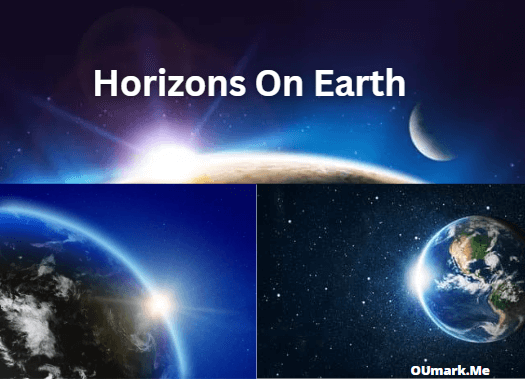Exploring the Horizons From Earth to the Universe
Introduction
Definition of horizon: The horizon is the line at which the Earth’s surface appears to meet the sky. It is the boundary between what is visible and what is not, and it changes depending on a person’s location and the time of day.
Importance of studying horizons: Understanding the horizon helps us to better understand the world around us, including the Earth’s curvature, the behavior of light, and the structure of the universe. It has also inspired many artistic and cultural works, and has played a role in the development of navigation and transportation.
Horizontal horizons on Earth

The visible horizon from a terrestrial perspective: From the ground, the horizon appears to be a circle surrounding us, with the sun, moon, and other celestial objects rising and setting along it. However, the horizon is actually a curved line due to the Earth’s curvature.
The role of Earth’s curvature in determining the horizon: The Earth’s curvature affects the horizon in two ways. First, it causes celestial objects to appear lower on the horizon as their distance from the observer increases. This is because the objects are actually below the observer’s line of sight, but their light is refracted (bent) by the Earth’s atmosphere. Second, the Earth’s curvature causes the horizon to appear closer or farther away depending on the observer’s altitude. At high altitudes, the horizon appears farther away due to the increased curvature of the Earth’s surface.
The concept of altitude and how it affects the horizon: Altitude is the height of an object above a reference point, such as sea level. The higher an observer is above sea level, the further away the horizon appears due to the Earth’s curvature. This can be demonstrated by climbing a mountain or flying in an airplane.
Celestial horizons in the solar system

The horizons of other planets and moons in the solar system: The horizons of other celestial bodies in the solar system differ from that of Earth due to their different shapes, sizes, and atmospheric conditions. For example, the horizon on Mars is much further away due to its smaller size and thinner atmosphere, while the horizon on Venus is closer due to its thick atmosphere. The moon also has a horizon, but it is not visible from the surface due to the lack of an atmosphere.
The importance of celestial horizons in space exploration: Understanding the horizons of other celestial bodies is important for space exploration, as it allows us to determine the locations and distances of objects in the solar system. It also helps us to understand the conditions on these bodies and how they compare to Earth.
Examples of celestial horizons in science fiction and popular culture: The concept of celestial horizons has inspired many works of science fiction, such as the “red horizon” on Mars in the novel “The Martian” and the “ringed horizon” of the gas giant Saturn in the film “Interstellar.” It has also been featured in science documentaries and video games.
Galactic Horizons In The Universe

The horizon of the Milky Way galaxy: The horizon of the Milky Way galaxy is the edge of the region that is visible to us due to the limited range of our telescopes. It is estimated to be about 50,000 light-years away, and beyond it lies the vast expanse of the universe.
The observable universe and the cosmic horizon: The observable universe is the portion of the universe that can be observed due to the finite speed of light.
The observable universe and the cosmic horizon: The observable universe is the portion of the universe that can be observed due to the finite speed of light. It is estimated to be about 93 billion light-years in diameter, and it is constantly expanding due to the expansion of the universe. The cosmic horizon is the edge of the observable universe, beyond which we cannot see due to the finite speed of light.
The concept of the event horizon in black holes: An event horizon is a boundary around a black hole beyond which nothing, not even light, can escape. It marks the point of no return for anything that falls into the black hole, and it is determined by the mass and spin of the black hole.
The role of horizons in cosmology and theories of the early universe: Horizons play a significant role in our understanding of the universe and its origins. For example, the cosmic microwave background radiation, which is thought to be the remnants of the Big Bang, is believed to have been emitted when the universe was just 380,000 years old and was still small enough for light to travel freely across its entire extent. This radiation provides us with a snapshot of the early universe and helps us to understand the conditions that existed at that time.
Conclusion
The importance of studying horizons in understanding the world around us: By studying horizons, we gain a greater understanding of the Earth, the solar system, and the universe as a whole. This knowledge helps us to better navigate and understand our place in the world, and it inspires us to explore and discover new things.
The potential for future discoveries and exploration of horizons in the universe: There is still much that we do not know about the universe, and the horizons that mark its boundaries provide endless possibilities for exploration and discovery. As our technology and understanding of the universe advances, we will continue to push the boundaries of what is known and uncover new mysteries about the world around us.
Thank you for reading.
